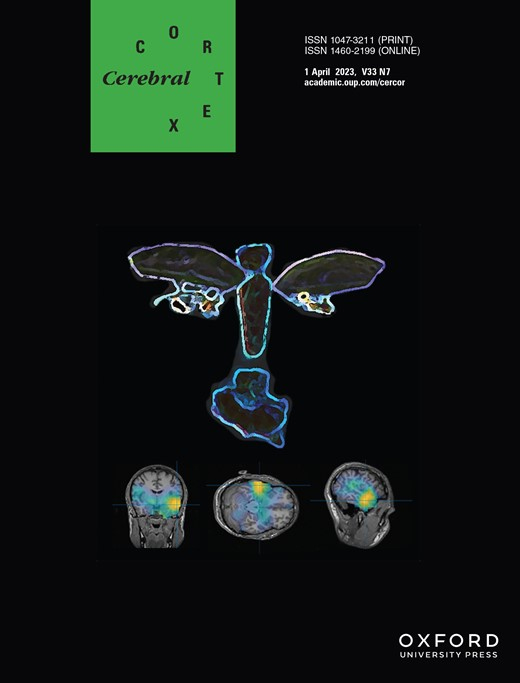- Submit a Protocol
- Receive Our Alerts
- Log in
- /
- Sign up
- My Bio Page
- Edit My Profile
- Change Password
- Log Out
- EN
- EN - English
- CN - 中文
- Protocols
- Articles and Issues
- For Authors
- About
- Become a Reviewer
- EN - English
- CN - 中文
- Home
- Protocols
- Articles and Issues
- For Authors
- About
- Become a Reviewer
A Standardized Protocol for Early-life Stress-induced Social Defeat in Mice
Published: Vol 13, Iss 12, Jun 20, 2023 DOI: 10.21769/BioProtoc.4703 Views: 1477
Reviewed by: HSIU CHUN CHUANGMohammed Mostafizur RahmanJordi Boix-i-CollAnonymous reviewer(s)

Protocol Collections
Comprehensive collections of detailed, peer-reviewed protocols focusing on specific topics
Related protocols
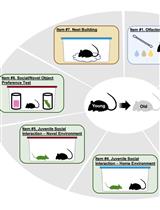
The Mouse Social Frailty Index (mSFI): A Standardized Protocol
Charles W. Collinge [...] Alessandro Bartolomucci
Apr 20, 2025 1765 Views
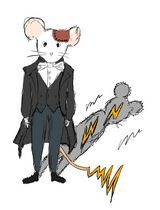
A Novel Composite Method of Post-stroke Epilepsy Induction
Yiting Guo and Raymond Tak Fai Cheung
Jul 20, 2025 1925 Views
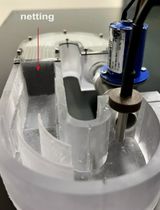
Station Holding During Rheotaxis: A Sensitive Assay of Lateral Line Function in Larval Zebrafish
Sophie Cohen-Bodénès [...] Lavinia Sheets
Dec 20, 2025 681 Views
Abstract
Neuropsychiatric diseases, like depression, have a considerable and persistent impact on human health; however, little is known about their underlying pathogenesis. Social defeat is a model for stress-induced psychopathologies that could present with behaviors resembling those observed in humans with depression. However, previous animal models of social defeat mainly focus on adults. Here, we re-design the protocol of early-life stress-induced social defeat paradigm, which is based on a classic resident–intruder model. Briefly, each two-week-old experimental mouse of C57BL/6 strain is introduced into the home cage of an unfamiliar CD1 aggressor mouse for 30 min per day for 10 consecutive days. Later, all experimental mice are raised individually for another month. Finally, the mice are identified as defeated through social interaction and open field tests. This model has been shown to be etiological and predictive and provide high validity and could be a powerful tool to investigate the underlying pathogenesis of early onset depression.
Graphical overview
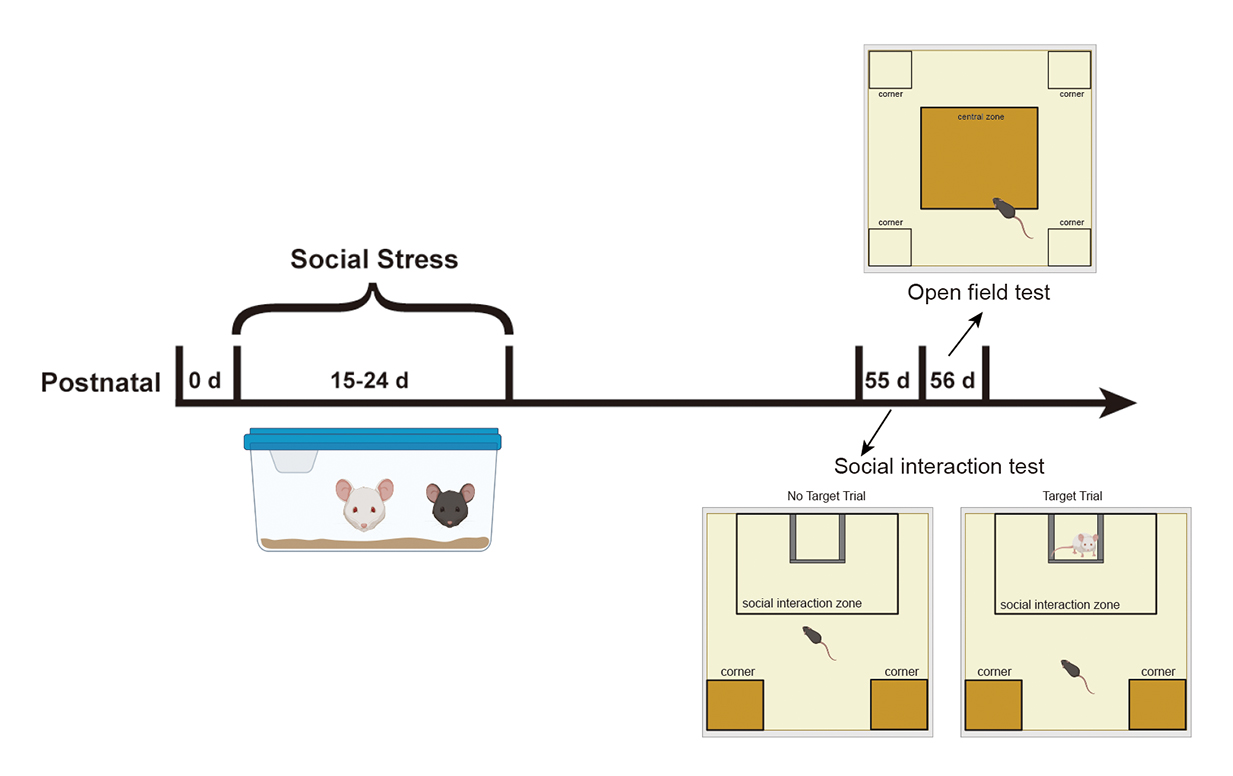
Background
Mood and anxiety disorders have a growing prevalence, potentially affecting one out of four people during their lifetime (Anacker et al., 2018; Du et al., 2021). This could result in a great burden for the affected individuals, their families, and the society. Establishing high-validity animal models is of great importance for exploring these diseases (Becker and Wojtowicz, 2007; Anacker and Hen, 2017; Anacker et al., 2018). It has been reported that social stress plays a central role in the pathogenesis of different psychiatric disorders (Padilla-Coreano et al., 2016). Thus, scientific researchers have strived to establish animal models of social defeat that would potentially provide significant and basic information for understanding several of the physiological and behavioral abnormalities induced by social stress between individuals (Snyder et al., 2001; Golden et al., 2011; Dioli et al., 2017).
Several forms of animal models have been established, including learned helplessness, chronic unpredictable mild stress (CUMS), chronic restraint stress, chronic social defeat stress (CSDS), and others (Toyoda, 2017). Each protocol has its advantages and disadvantages. For example, the CUMS model is widely regarded as the most classic animal model of depression in use. One of its main advantages is its ability to avoid adaptive responses in animals caused by single and repetitive stimuli. However, this model also has some drawbacks, such as a lengthy modeling time and a large workload required. Our protocol is based on the CSDS model; briefly, it is established based on intermittent physical interaction between a dominant resident and a submissive intruder (Schloesser et al., 2010; Golden et al., 2011; Anacker et al., 2018).
Modifications have been made to the CSDS model according to different study aims, mainly regarding species and strains being chosen, acute or chronic exposure to stress, and the terminologies used for identifying social defeat (Anacker et al., 2016; Castilla-Ortega et al., 2016; Du et al., 2021). Here, we introduce a general procedure of a social defeat paradigm, with a focus on early-life stress. In order to enhance the aggression level of the resident mice, we chose older CD1 mice and younger C57BL/6 mice as aggressors and intruders, respectively. The C57BL/6 strain has been reported to have a greater metabolic susceptibility to social defeat stress; we chose male mice as they show territorial behavior more universally and stably than female mice. The behavioral features of social defeat are evaluated by subsequent social interaction test (SIT) and open field test (OFT). SIT is a simple test in which behaviors and staying time in the interaction and corner zones are video recorded. Compared to a normal C57 mouse, which is motivated to explore, a mouse subjected to social defeat would like to avoid the CD1 mouse in the wire mesh (Golden et al., 2011). OFT is a common measure of exploratory behavior and general activity of mice. The recording of outcomes like center time is likely to gauge some aspects of emotionality, including anxiety and depression. This model could be used for exploring specific molecular mechanisms of early-life stress-induced social defeat and depression and may open opportunities for the development of new antidepressant drugs.
Materials and reagents
C57BL/6 mice (Beijing Vital River Laboratory Animal Technology Co., Ltd). Mice have free access to water and food on a 12:12 h light/dark cycle. Male and female mice were bred to generate pup litters for the experiments. In general, experiments are run in cohorts of 20–40 mice at one time.
Male CD1 mice (Beijing Vital River Laboratory Animal Technology Co., Ltd). Mice were single housed with free access to water and food on a 12:12 h light/dark cycle. CD1 mice should be single housed for at least a week before aggression screening.
Surgical scissors and suture (RWD, catalog number: SP0009-M)
Isoflurane (RWD, catalog number: R510-22-10)
Cleaning solution (Oxytech, catalog number: D-50/500)
Equipment
Arena (Wuhan Yihong Technology Co., Ltd, catalog number: YH-OF-M/R): 48 cm × 48 cm × 40 cm with an empty wire mesh enclosure (10 cm × 10 cm × 15 cm) alongside the middle of one of the arena walls. The 10 cm wide area surrounding the wire mesh cage is called the social interaction zone; the opposing corners in the arena are called corner zones (Figure 1A).
Arena (Wuhan Yihong Technology Co., Ltd, catalog number: YH-OF-M/R): 48 cm × 48 cm × 40 cm with a center zone (20 cm × 20 cm) and four corner zones (10 cm × 10 cm) (Figure 1B)
Video recording equipment (EthoVision XT) (Figure 1C)
Stopwatch for timing
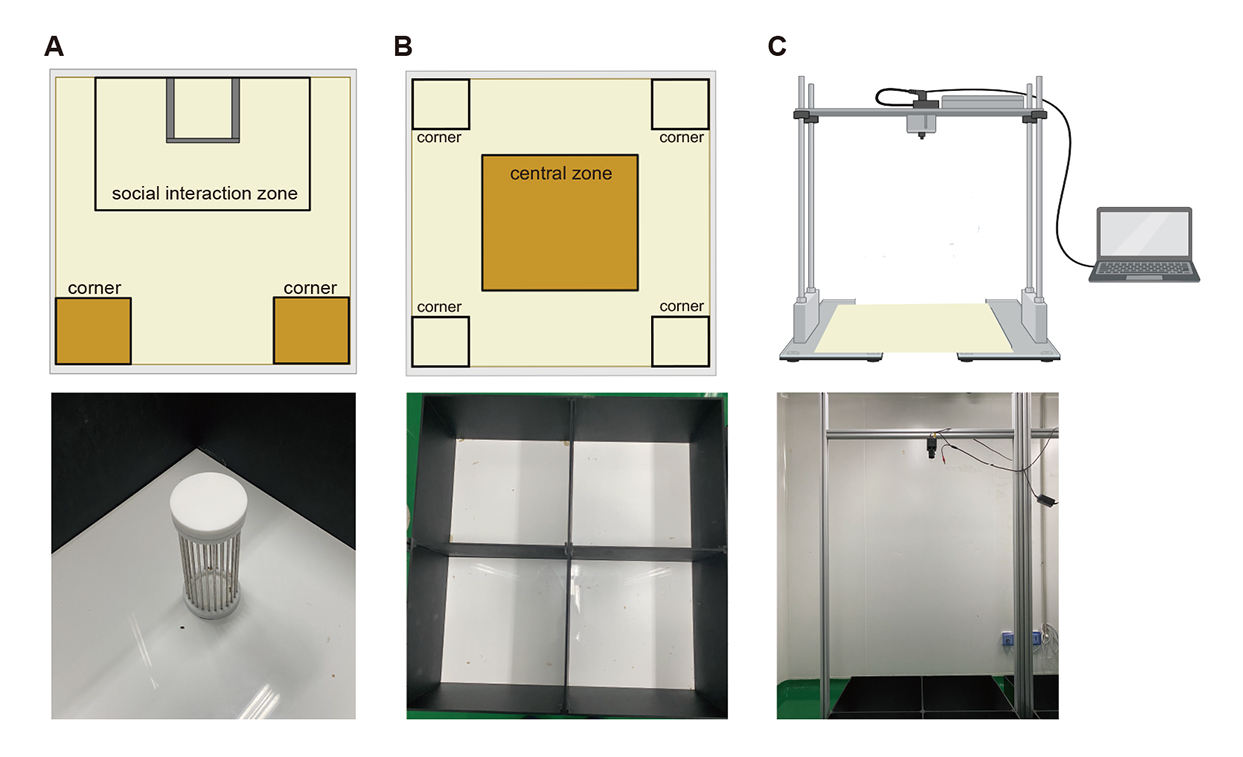
Figure 1. Schematic and physical objects of the social interaction arena (A), open field arena (B), and video-tracking equipment (C)
Software
EthoVision XT software (Noldus, https://www.noldus.com/ethovision-xt) or other video-tracking packages.
GraphPad Prism Software (version 7.0) or other statistical software.
Procedure
Aggression screening
Introduce a novel C57BL/6 mouse (8–16 weeks old) into the home cage of single-housed CD1 mouse (4–6 months old).
Record attack latencies of CD1 mice during a 3 min testing session.
Repeat the procedure for three consecutive days, using different C57BL/6 mouse for each CD1 mouse each day.
Select CD1 mice that attacked within 60 s for at least two consecutive days as aggressors.
Resect the gonads of selected CD1 aggressors (refer to Sophocleous and Idris, 2019) using surgical scissors and sutures and isoflurane, to avoid harmful behaviors against experimental mice in subsequent experiments.
Reuse CD1 aggressors for different pup litters for no longer than three months.
Early-life social defeat paradigm
Randomly assign mouse pup litters to control and experimental groups at postnatal day 15 (PD 15).
Introduce each pup of the experimental group into the home cage of an unfamiliar CD1 aggressor for a session of 30 min.
Place the pup litters back in their home cages with dams.
Repeat the aggression with different resident home cages every day from PD 15 to PD 24.
Keep pups in the control group undisturbed from PD 15 to PD 24.
Raise all experimental mice individually in their cage after the 10 day social defeat for a month.
Social interaction test (SIT)
Conduct the SIT on PD 55 between 10:00 and 14:00.
No target trial: introduce experimental and control mice into the arena while the wire mesh enclosure is empty for 300 s.
Analyze the time that experimental mice spend in the social interaction and corner zones with EthoVision XT.
Remove the experimental mice from the arena and place them into their home cage for 1 min.
Target trial: place an unfamiliar CD1 mouse into the wire mesh enclosure of the arena.
Introduce experimental mice into the arena for another 300 s.
Analyze the time that experimental mice spend in social interaction zone and corner zones with EthoVision XT.
Clean the arena and wire mech enclosure with odorless cleaning solution and wipe dry.
Open field test (OFT)
Conduct the OFT on PD 56 between 10:00 and 14:00.
Introduce each experimental mice into the arena for 10 min.
Analyze the time that experimental mice spend in the central and corner zones of the open field arena with EthoVision XT.
Analyze the total distance traveled by experimental mice with EthoVision XT.
Clean the arena with odorless cleaning solution and wipe dry.
Data analysis
Analyze all data with GraphPad Prism Software (version 7.0) or any other type of statistical software.
Assess the normality of the distribution with Kolmogorov–Smirnov test.
Present data of different groups as mean ± standard error of mean.
Use an unpaired 2-tailed Student’s t-test/two-way analysis of variance (ANOVA) for comparisons among groups.
Define statistical significance as p < 0.05.
Acknowledgments
W.D.N. designed the experiments. W.D.N. and Y.Z. performed the experiments. Y.Z. wrote the article and W.D.N. revised the manuscripts. We thank L.H.C. for his helpful review of this manuscript. We thank S.J.R. for their previous work on animal models of social defeat.
This research was supported by the National Natural Science Foundation of China (82102301 to W.D.N.), National Post-doctoral Program for Innovative Talents of China (BX20190226 to W.D.N.).
Competing interests
The authors declare that they have no conflicts of interest.
Ethics
All procedures involving animals were approved by the Association for Assessment and Accreditation of Laboratory Animal Care and the Institutional Animal Care and Use Committee of Sichuan University. All efforts were made to minimize the suffering of mice.
References
- Anacker, C. and Hen, R. (2017). Adult hippocampal neurogenesis and cognitive flexibility - linking memory and mood. Nat Rev Neurosci 18(6): 335-346.
- Anacker, C., Luna, V. M., Stevens, G. S., Millette, A., Shores, R., Jimenez, J. C., Chen, B. and Hen, R. (2018). Hippocampal neurogenesis confers stress resilience by inhibiting the ventral dentate gyrus. Nature 559(7712): 98-102.
- Anacker, C., Scholz, J., O'Donnell, K. J., Allemang-Grand, R., Diorio, J., Bagot, R. C., Nestler, E. J., Hen, R., Lerch, J. P. and Meaney, M. J. (2016). Neuroanatomic Differences Associated With Stress Susceptibility and Resilience. Biol Psychiatry 79(10): 840-849.
- Becker, S. and Wojtowicz, J. M. (2007) A model of hippocampal neurogenesis in memory and mood disorders. Trends Cogn Sci 11(2): 70-76.
- Castilla-Ortega, E., Serrano, A., Blanco, E., Araos, P., Suarez, J., Pavon, F. J., Rodriguez de Fonseca, F. and Santin, L. J. (2016). A place for the hippocampus in the cocaine addiction circuit: Potential roles for adult hippocampal neurogenesis. Neurosci Biobehav Rev 66: 15-32.
- Dioli, C., Patricio, P., Trindade, R., Pinto, L. G., Silva, J. M., Morais, M., Ferreiro, E., Borges, S., Mateus-Pinheiro, A., Rodrigues, A. J., et al. (2017). Tau-dependent suppression of adult neurogenesis in the stressed hippocampus. Mol Psychiatry 22(8): 1110-1118.
- Du Preez, A., Onorato, D., Eiben, I., Musaelyan, K., Egeland, M., Zunszain, P. A., Fernandes, C., Thuret, S. and Pariante, C. M. (2021). Chronic stress followed by social isolation promotes depressive-like behaviour, alters microglial and astrocyte biology and reduces hippocampal neurogenesis in male mice. Brain Behav Immun 91: 24-47.
- Golden, S. A., Covington, H. E., 3rd, Berton, O. and Russo, S. J. (2011). A standardized protocol for repeated social defeat stress in mice. Nat Protoc 6(8): 1183-1191.
- Padilla-Coreano, N., Bolkan, S. S., Pierce, G. M., Blackman, D. R., Hardin, W. D., Garcia-Garcia, A. L., Spellman, T. J. and Gordon, J. A. (2016). Direct Ventral Hippocampal-Prefrontal Input Is Required for Anxiety-Related Neural Activity and Behavior. Neuron 89(4): 857-866.
- Schloesser, R. J., Lehmann, M., Martinowich, K., Manji, H. K. and Herkenham, M. (2010). Environmental enrichment requires adult neurogenesis to facilitate the recovery from psychosocial stress. Mol Psychiatry 15(12): 1152-1163.
- Snyder, J. S., Kee, N. and Wojtowicz, J. M. (2001). Effects of adult neurogenesis on synaptic plasticity in the rat dentate gyrus. J Neurophysiol 85(6): 2423-2431.
- Sophocleous, A. and Idris, A. I. (2019). Ovariectomy/Orchiectomy in Rodents. Methods Mol Biol 1914: 261-267.
- Toyoda, A. (2017) Social defeat models in animal science: What we have learned from rodent models. Anim Sci J 88(7): 944-952.
Article Information
Copyright
© 2023 The Author(s); This is an open access article under the CC BY-NC license (https://creativecommons.org/licenses/by-nc/4.0/).
How to cite
Yang, Z. and Wang, D. (2023). A Standardized Protocol for Early-life Stress-induced Social Defeat in Mice. Bio-protocol 13(12): e4703. DOI: 10.21769/BioProtoc.4703.
Category
Neuroscience > Behavioral neuroscience > Animal model
Do you have any questions about this protocol?
Post your question to gather feedback from the community. We will also invite the authors of this article to respond.
Share
Bluesky
X
Copy link


